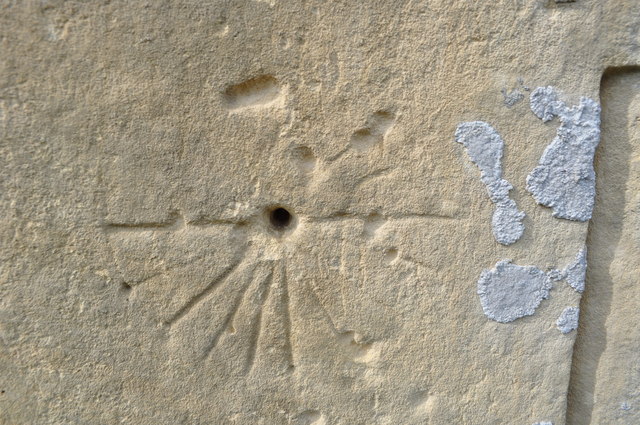TM3896 : Circles in the Limestone
taken 14 years ago, near to Hales, Norfolk, England

I have been kindly emailed with a great explanation.
"Normally located near the south porch of old churches. Usually about six to ten inches across with radiating lines coming from a central hole. These were used by priests as clocks to determine the time for mass. A wooden peg known as a gnomon (Greek indicator) was placed in the hole and the shadow cast by the sun moved round the dial. When the shadow touched one of the radiating lines it was time for a mass."
The isolated church is a rare Norman 12th-ventury survivor, its surrounding medieval village and manor houses being long forgotten. The new village of Hales is now 1km to the north.
The nave and chancel are constructed from whatever the builders could find, from Roman tiles Link to glacial erratics Link and ferruginous conglomerate Link. Limestone was imported from Caen, Normandy to finish off the nice areas and carve the doorways Link Link. The rough wall was plastered white with four simple windows of which one survives Link. Soon after the church was finished the tower was added, slightly rougher in construction Link. Evidence suggests a completion date for the nave and chancel of 1140. Originally the chancel was barrel vaulted; however, this was taken down or fell down, then the nave and chancel extended in height by 90cm. This work seems to have been done in the 13th century with the vault collapse/removal.
In 1270 the church was granted by Alan, son of Elias of Heckingham and Ralph de Chedgrave and his wife Emma to St Olave's Priory Link. The last mentioned vicar was in 1458 (Hugh Croke) before the priory closed the vicarage after appropriation. Stripped of its living the church became rather poor. Because of this the chancel was never "straightened out" unlike at Poringland. Link. With the dissolution of the monasteries in 1537 the church passed to the Crown, where an impropriator was paid £5 per annum to look after it. In 1841 the churches of Heckingham and Hales joined under one impropriator. The church was made redundant in 1973 after years of no services and is now under the care of the Churches Conservation Trust Link.
Inside there are several nice early 14th-century wall paintings, St Christopher and St James for example. The octagonal font is rather modern for this church being from the 15th century.
